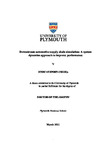Downstream automotive supply chain simulation: A system dynamics approach to improve performance
| dc.contributor.supervisor | Moizer, Jonathan | |
| dc.contributor.author | Chizea, Jindu Stephen | |
| dc.contributor.other | Plymouth Business School | en_US |
| dc.date.accessioned | 2021-03-16T10:46:34Z | |
| dc.date.issued | 2021 | |
| dc.identifier | 10537531 | en_US |
| dc.identifier.uri | http://hdl.handle.net/10026.1/16944 | |
| dc.description.abstract |
Supply chain instabilities and fluctuations commonly known as (Bullwhip Effect) have been existing and is known for many years as a problem for companies. The bullwhip effect is an occurrence indicating a situation where there is an amplification of demand fluctuations as orders move upstream from customers to suppliers and this can be costly and disadvantageous for supply chains as it causes problems in form of excessive inventory, excessive capacity, which causes high cost and low profit for companies. This thesis presents the analysis of the dynamic behaviour arising from the bullwhip effect using two inventory models in the downstream automobile supply chains in Nigeria. Models of push and hybrid push/pull inventory models are developed using system dynamics modelling methodology by allowing comparisons between the two inventory models. Although, there are number of literatures that have discussed these supply chain inventory models using system dynamics by evaluating their performance, this research has a different approach by using actual case study in Nigeria. The inventory models allow the investigation of the bullwhip effect in the downstream automobile companies in Nigeria using different demand patterns (business as usual, optimistic and pessimistic demand patterns) as input in order to show the uncertainty in customer demand. This problem remains one of the most difficult issues to resolve by the managers. The results from the investigation through simulation runs are analysed comparatively. Performance metrics used for measuring the performance of these models are distributor inventory, dealer inventory, total cost, profit and cash balance. The instabilities and fluctuations can be observed arising from the downstream by customers placing orders, through dealers before orders moves upstream to the distributor. This is the point where this study suggests policy interventions for managers. Findings from the analysis provides insight how these instabilities occur from uncertain demand and its effect on the two inventory models together with the costs involved. Finally, sensitivity analysis is conducted on the parameter values in the models to reduce the total cost and improve profit and cash balance. This investigation shows that system dynamics modelling methodology can be a useful methodology tool for managers in making decisions regarding inventory policies. | en_US |
| dc.language.iso | en | |
| dc.publisher | University of Plymouth | |
| dc.rights | Attribution 3.0 United States | * |
| dc.rights.uri | http://creativecommons.org/licenses/by/3.0/us/ | * |
| dc.subject | Supply chain management | en_US |
| dc.subject | System dynamics modelling | |
| dc.subject | Bullwhip effect | |
| dc.subject | Automotive supply chain | |
| dc.subject | Ordering policy and decisions | |
| dc.subject.classification | PhD | en_US |
| dc.title | Downstream automotive supply chain simulation: A system dynamics approach to improve performance | en_US |
| dc.type | Thesis | |
| plymouth.version | publishable | en_US |
| dc.identifier.doi | http://dx.doi.org/10.24382/1105 | |
| dc.identifier.doi | http://dx.doi.org/10.24382/1105 | |
| dc.rights.embargodate | 2022-03-16T10:46:34Z | |
| dc.rights.embargoperiod | 12 months | en_US |
| dc.type.qualification | Doctorate | en_US |
| rioxxterms.version | NA |
Files in this item
This item appears in the following Collection(s)
-
01 Research Theses Main Collection
Research Theses Main



